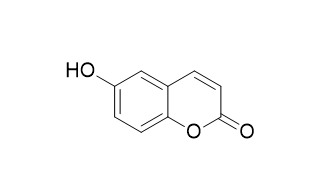6-Hydroxycoumarin
6-Hydroxycoumarin has antioxidant, antimicrobial, and anti-tumour activities.
Inquire / Order:
manager@chemfaces.com
Technical Inquiries:
service@chemfaces.com
Tel:
+86-27-84237783
Fax:
+86-27-84254680
Address:
1 Building, No. 83, CheCheng Rd., Wuhan Economic and Technological Development Zone, Wuhan, Hubei 430056, PRC
Providing storage is as stated on the product vial and the vial is kept tightly sealed, the product can be stored for up to
24 months(2-8C).
Wherever possible, you should prepare and use solutions on the same day. However, if you need to make up stock solutions in advance, we recommend that you store the solution as aliquots in tightly sealed vials at -20C. Generally, these will be useable for up to two weeks. Before use, and prior to opening the vial we recommend that you allow your product to equilibrate to room temperature for at least 1 hour.
Need more advice on solubility, usage and handling? Please email to: service@chemfaces.com
The packaging of the product may have turned upside down during transportation, resulting in the natural compounds adhering to the neck or cap of the vial. take the vial out of its packaging and gently shake to let the compounds fall to the bottom of the vial. for liquid products, centrifuge at 200-500 RPM to gather the liquid at the bottom of the vial. try to avoid loss or contamination during handling.
Eur J Pharmacol.2018, 832:96-103
Food Funct.2022, 13(23):12105-12120.
Eur J Pharmacol.2022, 917:174744.
Molecules.2017, 22(11)
Biomolecules.2023, 13(2):227.
Universitat Stuttgart2022, opus-12200.
Chin J Pharm Anal.2019, 39(7):1217-1228
Food and Fermentation Industries2018, 44(371)
Eur J Pharmacol.2024, 978:176749.
J AOAC Int.2024, qsae028.
Related and Featured Products
Bioorganic & Medicinal Chemistry Letters, 2014, 24(17):4243-4246.
Synthesis and biological evaluation of novel isoxazoles and triazoles linked 6-hydroxycoumarin as potent cytotoxic agents.[Reference:
WebLink]
METHODS AND RESULTS:
A new series of diverse isoxazoles and triazoles linked 6-Hydroxycoumarin (1) were synthesized using click chemistry approach. All the derivatives were subjected to 3-(4,5-dimethylthiazol-yl)-diphenyl tetrazoliumbromide (MTT) cytotoxicity screening against a panel of five different human cancer cell lines viz. prostate (PC-3), colon (HCT-116 and Colo-205), leukemia (HL-60) and lung (A-549) to check their cytotoxic potential. Interestingly, among the tested molecules, some of the analogs displayed better cytotoxic activity than the parent 6-Hydroxycoumarin (1). Of the synthesized isoxazoles, compounds 10 and 13 showed the best activity with IC50 of 8.2 and 13.6 μM against PC-3 cancer cell line, while as, among the triazoles, compounds 23 and 25 were the most active with the IC50 of 10.2 and 12.6 μM against A-549 cancer cell line. The other derivatives showed almost comparable activity with that of the parent molecule.
CONCLUSIONS:
The present study resulted in identification of ortho substituted isoxazole and triazole derivatives of 6-Hydroxycoumarin as effective cytotoxic agents against prostate (PC-3) and lung (A-549) cancer cell lines, respectively.
PhD thesis, Dublin City University.(1999)
Studies on the mode of action of coumarins (coumarin, 6-hydroxycoumarin, 7-hydroxycoumarin & esculetin) at a cellular level.[Reference:
WebLink]
Coumarin, a member of the benzopyrone family of compounds, is a natural substance that has shown anti-tumour activity in vivo, with this effect believed to be due to its metabolites. However, no definitive mode o f action has been identified, and this thesis aimed at gaining further insight into the precise target o f coumarin molecules at a cellular level.
METHODS AND RESULTS:
A novel biosensing instrument, the Cytosensor Microphysiometer, which detects cellular metabolism, was used throughout, to aid this investigation. The effect o f four coumarin compounds (coumarin, 6-Hydroxycoumarin, 7-hydroxycoumarin and esculetin) on the growth, metabolism and metastatic potential of a range o f tumour cell lines was investigated. The toxicity o f these four compounds was examined using a variety of in vitro tests (medium-term growth assays, Lactate dehydrogenase (LDH) assay and a tetrazolium salt-based (MTT) assay). A superior method to the MTT assay for examining the effect of compounds on metabolism was achieved using the Cytosensor Microphysiometer. The effect of coumarins on the metastatic potential of tumour cells (in terms o f their protease secretion) was also explored. The effect o f 7-hydroxycoumarin and esculetin on growth signalling pathways within tumour cells was probed. Using the A431 cell line (which over-expresses the EGF-Receptor) and EGF as a model growth factor signalling mechanism, the effect of the two coumarins on tyrosine phosphorylation events in cells was explored. Direct in vitro tyrosine kinase assays with purified EGFreceptor, and ELISA, Western Blotting and Cytosensor studies in intact cells, were used to achieve this. The involvement o f coumarin compounds in protein kinase C signalling was also examined.
CONCLUSIONS:
A “model” monocyte system was developed and used in a preliminary assessment of the immunomodulatory role of coumarins. The activation of two “monocytic” cell lines was assessed using the Cytosensor Microphysiometer. Subsequently, the effect o f coumarins on the release of reactive oxygen species, reactive nitrogen intermediates and proteases from activated immune cells, was accomplished using luminometric, colourimetric and substrate gel analyses, respectively.
Phytochemistry, 1971, 10(12):2971-2974.
Antimicrobial properties of 6,7-dihydroxy-, 7,8-dihydroxy-, 6-hydroxy- and 8-hydroxycoumarins.[Reference:
WebLink]
METHODS AND RESULTS:
The effects of daphnetin, aesculetin, scopoletin, 6-Hydroxycoumarin and 8-hydroxycoumarin and their alkyl and acyl derivatives on the growth of bacteria and fungi are reported.
Journal of Pharmaceutical Sciences and Research, 2013, 4(6):1859-1860.
Isolation and identification of anti oxidizing agents from Alyxia reinwardtii.[Reference:
WebLink]
METHODS AND RESULTS:
Eight compounds were isolated from the stems of Alyxia reinwardtii, namely coumarin (1), 3-hydroxycoumarin (2), 6-Hydroxycoumarin (3), 8-hydroxycoumarin (4), scopoletin (5), (+)-pinoresinol (6), zhebeiresinol (7) and p-hydroxybenzoic acid (8). The structures of all compounds were characterized by means of NMR, MS, chemical analysis and comparison with the literature data. The structure of compound 7 was also confirmed by X-ray crystallography. To the best of our knowledge, compounds 2-3, 5 and 7-8 have been isolated for the first time from this species.
CONCLUSIONS:
In terms of antioxidant activity, the isolated compounds were evaluated by various in vitro model assays, which include the DPPH radical scavenging activity, xanthine oxidase-related activity (superoxide scavenging activity and inhibitory effect on xanthine oxidase) and lipid per oxidation inhibitory activity.



